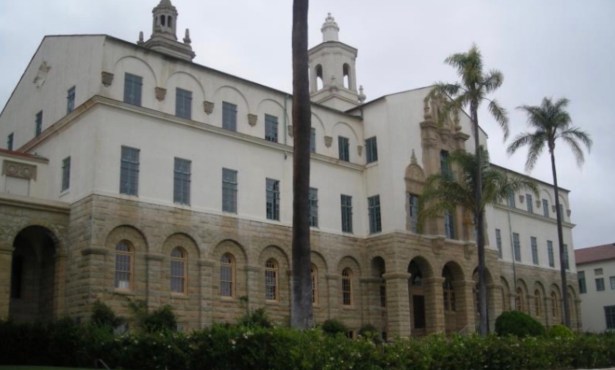Santa Barbara Debates Rat Problem
City Hall Denies Parklets Are Bringing More Vermin

“I really want to get off this rat thing,” protested the ever-outspoken Kelly Brown, owner of The Natural Café on the 500 block of State Street. “Rats are not the real issue; it’s the stuff of newspaper headlines,” he insisted.
In this case, however, it was Brown himself who put the verboten vermin on the front pages of Santa Barbara’s news periodicals about a month ago when he announced that he and his Natural Café — ensconced in downtown Santa Barbara for the past 30 years — were pulling up roots early next year. In a letter to his landlord, Jim Knell of SIMA Corporation, Brown proclaimed, “The rat/vermin problem, which starts with the city and their lack of any program to address this, has in the last few years become intolerable.” The letter has since been widely recirculated. “Look under any parklet and you will find rat nests. Food is just falling from above.”
To be clear, rats and vermin were just one of many reasons cited by Brown as to why the business climate has grown from bad to worse. But they grabbed the most attention. Last week, administrators at City Hall took issue with Brown’s remarks, stating they are contracting with Lenz Pest Control to the tune of $18,000 a year to rid State Street and Coast Village Road of rats. The program has been in effect for 10 years. Lenz places 90 traps — most of which are the big black-box variety that rats can get into but not out of — throughout multiple rights-of-way between the 200 and 1200 blocks of State Street.
Between August and October of this year, Lenz has caught 74 rats. Of those, nine were trapped on the 500 block. About the same number were trapped on Coast Village Road. That translates to roughly $50 a rat. Those numbers are reportedly about the same — or even slightly lower — as they were during the pre-parklet days when the council shut down State Street to car traffic as an emergency stopgap measure designed to keep businesses humming during COVID. “There has been no appreciable increase since the parklets arrived,” said city administrator Sarah Clark.
Brown took issue with the black-box traps, stating they were not particularly effective as they could only trap one rat and were changed only once a week. Dale Shreve of Lenz was quick to praise Kelly Brown as a fine restauranteur, but cautioned, “He is not a rat expert. I have been working with rats for 26 years now.”
There’s more to rodent control, said Shreve, than merely killing rats. It’s also about reducing places where they can find harbor and nest. Rats breed up to six times a year and have up to 12 babies per litter. When Lenz started out, Shreve said, they caught 200 the first month. The most ever was 320. Now it’s down to 40-50. “A lot of effort has gone into getting those numbers low,” he said.
The rats on State Street are coming from structures surrounding Santa Barbara’s main thoroughfare that are not being maintained, he stated. Shreve noted that no poison is used, but that the box traps are checked twice a week. Lenz also baits the traps with something called Detex that makes rat poop visible when illuminated with a black light. As far as food scraps are concerned, Shreve noted, it’s always been part of the downtown ecosystem and always will be. “It is State Street,” he said.
When Lenz first started on State Street, Shreve said, “Rats were jumping out of trash cans and running around city bathrooms.” That doesn’t happen anymore because the traps they use are effective, he said, because they’re baited to smell like rat urine and feces. “This is the biggest attractor to other rats,” he explained. “It is a beacon to every rat.”
Sign up for Indy Today to receive fresh news from Independent.com, in your inbox, every morning.
While rats on State Street date back to the city’s founding, Brown’s comments provided an accelerant to the already smoldering debate over downtown parklets. Brown said many of the parklets were ratty-looking and gave the downtown an overall ratty ambience. “There are no standards,” he bemoaned.
“It’s just not Santa Barbara.”
Not all in his business agree. Brown got a hot reception at a meeting of 17 like-minded business owners last week at a meeting convened by Santa Barbara Downtown’s Food and Beverage Committee who took issue with many of his remarks. “I’m just saying what everyone knows but isn’t saying,” he said.
Bob Stout, a major player in the downtown organization with nearly 40 years in Santa Barbara’s food and beverage industry, sees it otherwise. “This idea of food falling through the cracks makes no sense,” he said. “Parklet floors are made of solid plywood; they don’t have ‘cracks’ for the food to fall down.” Stout noted that two breweries on the 600 block of State — Night Lizard and M. Special — cleaned out the space under their parklets this past weekend. In neither case was any evidence of rats found, he said.
More to the point, Stout stated, people are now coming downtown because they are drawn to the new car-free State Street. They like the parklets. Yes, he acknowledged, some were put together in a hurry and need work. But he said City Hall has adopted new standards for design and stormwater runoff that will go into effect as December 2 for the latter and February for the former. Brown and other critics of the parklets need to give the new standards time before they judge the program a failure. Stout cited a survey commissioned by Santa Barbara Downtown showing that 793 out of 894 respondents reporting they go downtown more often since the promenade was opened. Of those, 897 said they went downtown for food and beverages; 840 said they preferred to eat outdoors than inside. The vast majority said they would be more likely to visit a business with a parklet and that parklets should be allowed and encouraged on the side streets off of State.
The debate will continue at least until the subcommittee now exploring the long-term future of State Street comes to some conclusions two years hence. If City Hall is serious about revitalizing downtown, said Brown, it should look to Boise’s experience converting fallow retail and office space into workforce housing rather than parklets. Given Santa Barbara’s astronomical real estate costs, it’s questionable just how workforce-friendly such housing could actually be. “If there were any easy answers out there,” Brown said, “we would have found it a long time ago.”
Support the Santa Barbara Independent through a long-term or a single contribution.



